When aliens come to Earth, they get studied at Area 51 ... or, at least, that's what some people will tell you. Is is true? Well, there's no question that this creepy government facility in the middle of the Nevada desert, officially called Groom Lake, has kept many secrets locked up in its vaults. So far, though, there's been no proof that a bunch of little green extraterrestrials are one of them.
That hasn't stopped people from speculating about — or threatening to "naruto run" into — the guarded facility, and considering that it took over a half-century for the United States government to even admit that Area 51 existed, you can't blame folks for not trusting the official story. What can be confirmed about Area 51, for sure, is that it's a place of high-tech military tests and shady cover-ups, the likes of which you would normally only find in an episode of "Stranger Things." Here's what we know about Area 51.
HOW THE SHADY BUSINESS AT AREA 51 ALL GOT STARTED
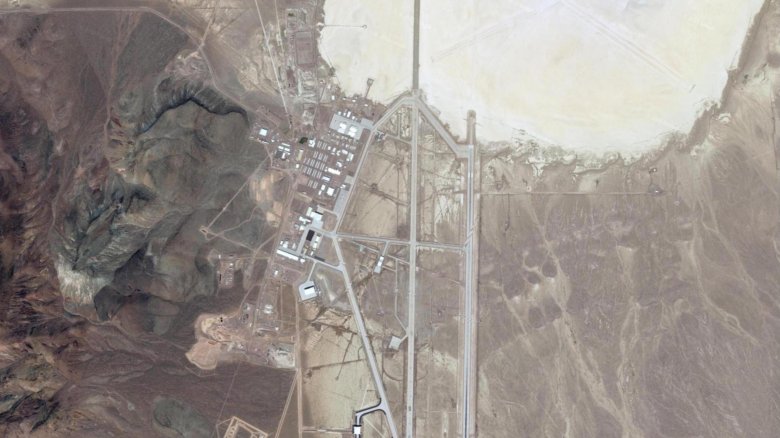
Shutterstock
Okay, so when you're talking about Area 51, separating fact from fiction is a tricky matter. That said, the Nevada Historical Society reports that this whole shebang got started during World War II. Somewhere between harnessing atomic energy and turning a skinny kid named Steve Rogers into a super-soldier, the U.S. military built a pair of small runways right next to Nevada's Groom Lake and named it the Army Air Corps Gunnery School. Sometime after the war, the Gunnery School was abandoned. No biggie.
Enter the paranoid 1950s, whereupon the equally-paranoid CIA teamed up with the somehow-even-more-paranoid Lockheed aerospace corporation. Their joint project, labeled Skunk Works, was intended to develop U-2 spy planes. The secrecy of the project meant that test flights had to be done in a remote location, far away from commercial and military flight paths, but close enough to a major city that receiving new supply shipments wouldn't be a total pain in the neck. Luckily, the project's Air Force liaison mentioned that nice little abandoned Gunnery School in Nevada where he had trained. After close inspections, Skunk Works moved in, set up shop, and started testing their spy planes.
Obviously, they didn't tell any of this to the press. Their cover story was to refer to the military base as "Watertown" and claim that they were merely studying weather phenomena, as per "Area 51," by Peter Merlin. Huh, sounds familiar.
THE GOVERNMENT DIDN'T OFFICIALLY ACKNOWLEDGE AREA 51'S EXISTENCE ... UNTIL 2013
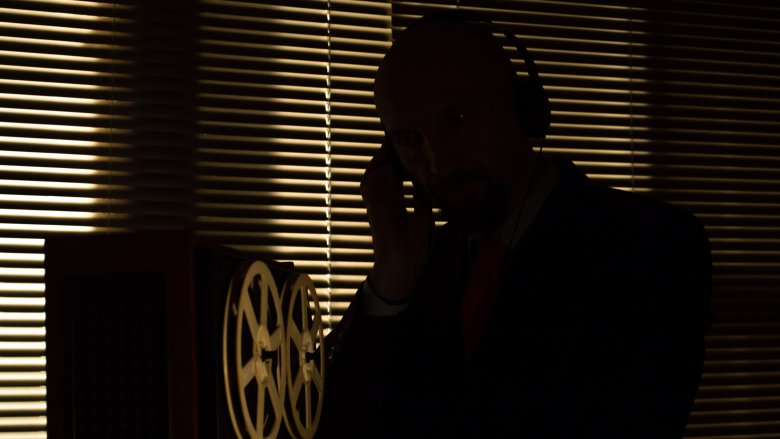
Shutterstock
These days, the existence of Area 51 is common knowledge. Nobody knows what they do there, exactly, but everyone knows that it's a real place. Throughout the entirety of the 20th century, though, the U.S. government refused to even admit that much. Yeah, seriously. It wasn't until 2013 that the CIA finally came clean about the test site's existence, according to Reuters, through declassifying some old documents about the subject. By this point, the "X-Files" theme was already embedded in people's brains, and decades of lying doesn't do a lot to inspire public trust, so a lot of people weren't too inclined to buy the CIA's fancy-schmancy story about the base being used to test fly high-tech military weaponry ... as opposed to, you know, studying alien bodies from the Roswell incident or what have you.
Nonetheless, much of what the world knows today about Groom Lake's history is thanks to the 400 pages the CIA made public, and it does seem quite credible that the base's primary intention has, indeed, been about testing experimental military aircraft. Now, as for aliens playing a role in those experiments? You be the judge.
THERE'S A CRAZY LEVEL OF SECRECY AT AREA 51
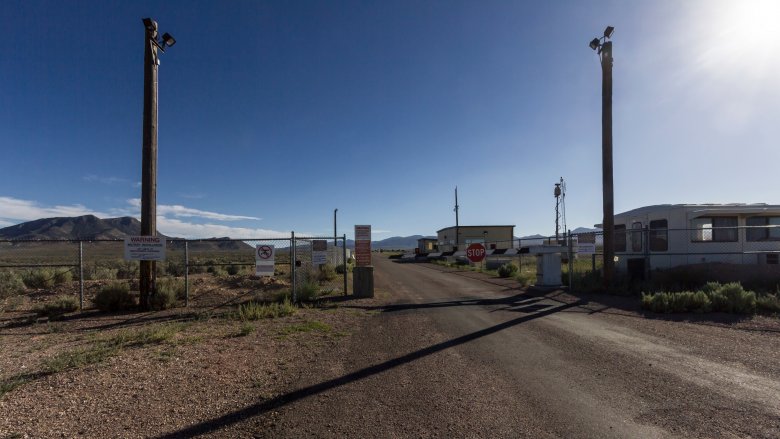
Shutterstock
If you're wondering how a sketchy government base could stay hidden so long, well, the cloud of secrecy surrounding Area 51 is big and foggy enough that even Agent K would get lost in it. First of all, as NPR points out, you have to understand that Area 51 isn't some dinky little hole in the desert. The base is stationed inside a 4,687-square-mile piece of land that's way bigger than Rhode Island, and almost the size of Connecticut. Whoa, right?
Secondly, they don't kid around when it comes to privacy invasions. According to How Stuff Works, any pilots brave enough to fly into the airspace above Area 51, named R-4808N, face a deadly trio of horrible consequences, starting with a court martial, leading to a dishonorable discharge, and potentially culminating in time behind bars.
Third, a former Area 51 worker named T.D. Barnes describes a professional environment so secretive that non-disclosure agreements are used for everything, the jobs don't officially exist on the books, and less than 5% of those on the base even knew the CIA was involved. In an interview with a local Las Vegas news station, Barnes said people on the base communicated with fake names and weren't even allowed to tell their families back home where they worked: Barnes' wife thought her husband commuted to a foreign country, until he told her the truth in 2009.
WHOA, HOLD ON. SO WHAT'S ACTUALLY AT AREA 51?
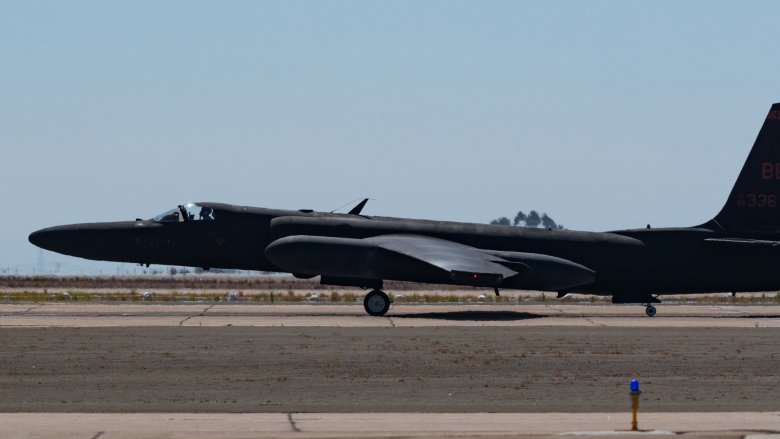
Shutterstock
The honest answer about what's really at Area 51 is "nobody knows for sure." Except for the people who do know, obviously, and they certainly aren't going to tell you about it.
That said, you can be reasonably certain that the whole area is used for testing high-tech experimental military aircraft, according to The Washington Post. The CIA's declassified documents definitely make it clear that this was how the base was used throughout most of the 20th century. In addition to those U-2 spy planes, How Stuff Works points out that Lockheed's A-12 Archangels were also tested there in the 1960s, followed by stealth fighters in the '70s, and Tacit Blue aircraft in the '80s. So, presumably, the military is currently flying some ludicrously advanced new aircraft models out there today, the likes of which we won't see unveiled to the public for another few decades. It makes sense.
... or, you know, they could have aliens there, right? Right? Considering it took decades for the U.S. government to even admit the place existed, lots of people still believe there's shady crap going on in there, whether UFO-related or not. You can't blame 'em for being suspicious, that's for sure.
WHERE'D ALL THESE ALIEN CONSPIRACIES COME FROM?

Shutterstock
Well, c'mon, when there's a mystery afoot, people always suspect aliens. Just ask that "aliens" dude on the History Channel. The real credit for establishing a permanent link between Area 51 and aliens, though, probably goes to a guy named Bob Lazar. Newsweek reported that in 1989, Lazar — under the pseudonym "Dennis" — told the press that he was a former scientist who had worked in Area 51, reverse-engineering nine extraterrestrial flying saucers. Boom.
Once "Dennis" spoke out, the world flipped on its axis. Nobody stormed Area 51, but the news spread like wildfire, and Lazar's story turned Area 51 into UFO central, forevermore. Soon afterward, Lazar came forward with his true identity, claiming that his family's lives had been threatened.
According to Vice, a lot of what made Lazar's story stick — and why it continues to gain support, to this day — is because he's clearly a smart guy. Back in 1989, for example, he explained that the alien spaceship used element 115, aka moscovium, to manipulate gravity for its propulsion system: an impressive concept, since the element didn't get synthesized in a lab until 2003. This isn't quite the smoking gun it sounds like, though. While Lazar's descriptions were certainly knowledgeable, it's also the sort of concept a clever science fiction author could cook up with some research. Lazar has credibility issues, too, as his claim of studying physics at MIT doesn't line up with MIT's records. Still, he has many followers.
UFO SIGHTINGS ABOUND AROUND AREA 51
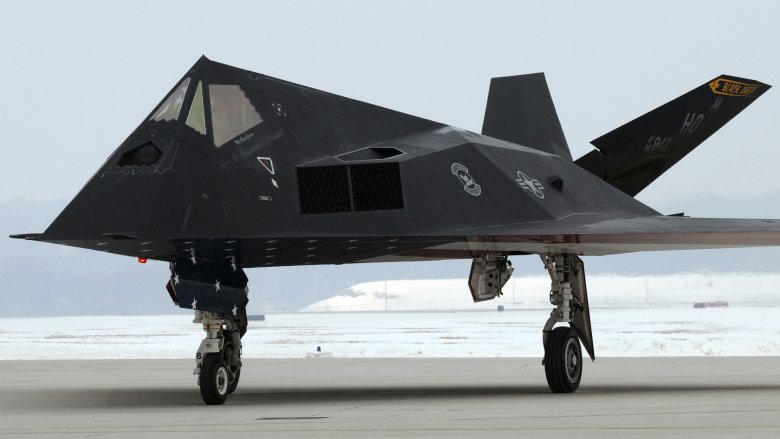
Shutterstock
Again, the official government line is that there are no flying saucers in Area 51. There have been plenty of UFO sightings in the area, according to Britannica, but these are generally chalked up to people misinterpreting real military tests. For example, imagine if you were in the 1970s and you saw something like the stealth fighter above zoom past your head. Wouldn't you be freaked out? Plus, once enough people say there are UFOs in a certain area, people tend to "see" more UFOs. So it goes.
That said, the CIA's declassified documents did contain at least one section regarding UFOs, which discusses something called Operation Blue Book. (Cue creepy music.) As summarized by Space.com, the CIA noted a dramatic increase in UFO sightings after the U-2s started being test-flown from Area 51, and while this seems like an obvious case of cause and effect, they did want to make sure. So they recorded UFO sightings, documented them, and compared the locations against U.S. aircraft flight logs to check that nothing funny was going on. Using this method, Blue Book officials were able to confirm that the majority of UFO sightings matched military aircraft flight patterns.
Note the word "majority," though. This terminology doesn't prove anything, and it's easy to jump to conclusions, but it is a word choice commonly seized upon by UFO folks. Again, believe what you will.
THEY'RE AWFULLY SERIOUS ABOUT SECURITY AT AREA 51
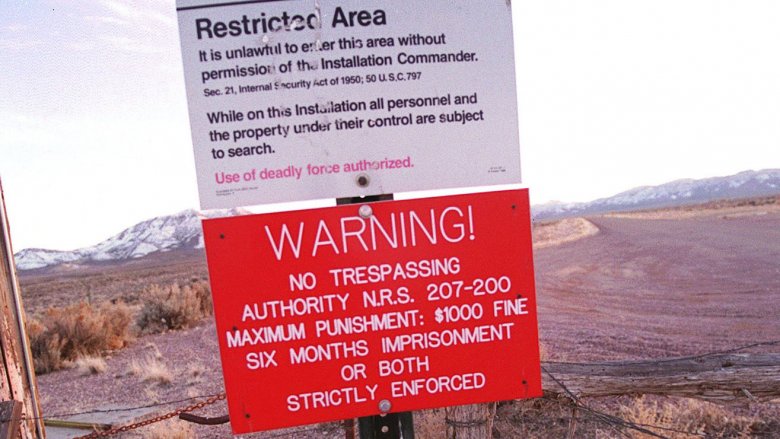
Dan Callister/Getty Images
If you're wondering how the U.S. government is legally able to keep people from entering Area 51, well, it's enshrined in the law. Section 1382 of Title 18, to be precise. According to IFL Science, Area 51 is surrounded by signs warning trespassers that they could be subject to deadly force, heavy fines, and/or prison time.
How seriously do they take these laws, though? After all, would they really shoot someone who charged past the barriers? Yes, actually. In January 2019, the Nevada National Security Site reported that an unidentified man holding a "cylindrical object" had broken in, driven 8 miles past the security gate, and ignored the commands of the officers who intercepted him. Yes, they shot him, and yes, he's dead now.
A somewhat less deadly incident occurred in 2014, when a tour van carrying four passengers accidentally crossed the boundary, according to Las Vegas Now. Two minutes later, the guards roared out in a white truck, stopped the van, and issued misdemeanor charges and $650 fines ... for each person in the van, passengers included. Thankfully, the charges were dropped for the passengers, but the driver was barred from doing Area 51 tours for two years.
THE 1974 SKYLAB PHOTOGRAPHY SNAFU
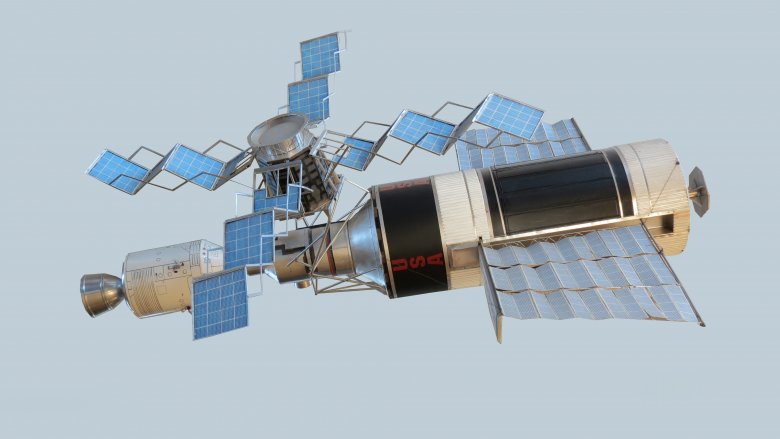
Shutterstock
You'd be hard pressed to find two government agencies more different than NASA and the CIA. While NASA is all about openness, the CIA hides things under the things it hides. These contradictory approaches came swinging at each other like two "Mortal Kombat" opponents back in 1974, according to the Space Review, when astronauts aboard the Skylab 4 mission accidentally snapped an aerial photograph of the infamous Area 51. Oops.
Now, keep in mind, at this point Area 51 was off the books, nonexistent, etc., so the CIA was extremely unhappy about having their dirty laundry put on camera. A CIA memo (PDF) dated April 19, 1974, states in clear terms that, "The issue arises from the fact that the recent SKYLAB mission inadvertently photographed [REDACTED]. There were specific instructions not to do this. [REDACTED] was the only location which had such instruction." This prompted a big battle, with NASA wanting to release the photo and the CIA resisting. In the end, though, the Space Review says that the photo was published in NASA's archive of Skylab pictures, so while NASA seems to have won, the photo (sans context) was so seemingly uninteresting that nobody noticed.
None of this came to light until 2006, by the way.
THE ONLY THING IN AREA 51 SCARIER THAN THE ALIENS? COMBAT DRONES
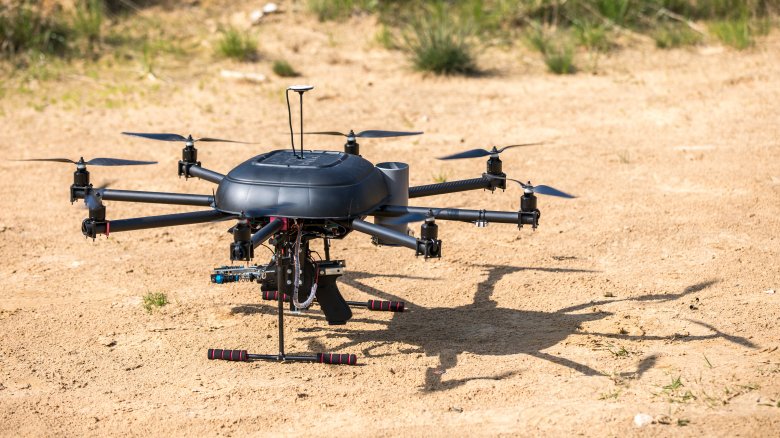
Shutterstock
Want to hazard a guess about where the CIA first tested the unmanned, flying death machines we now (incorrectly) call "drones"?
Area 51, of course. While this might sound like the sort of wacko theory that the conspiracy dude at your local bar would rant after a few drinks, The Washington Post confirms that it really happened. To make matters even creepier, drone development isn't a recent thing, either. The two drone programs at Area 51, named AQUILINE and AXILLARY, first got started in the '60s as a response to all the U-2 spy planes getting lost. Both of these projects ended up being canceled, as AQUILINE cost too much and AXILLARY was too loud for proper spy missions. However, they certainly paved the way for the deadly combat drones we see being used in wars today, and at least one of those AQUILINE prototypes took off from Area 51 over 20 times ... and, presumably, caused at least a few UFO sightings.
WHAT'S IN A NAME?
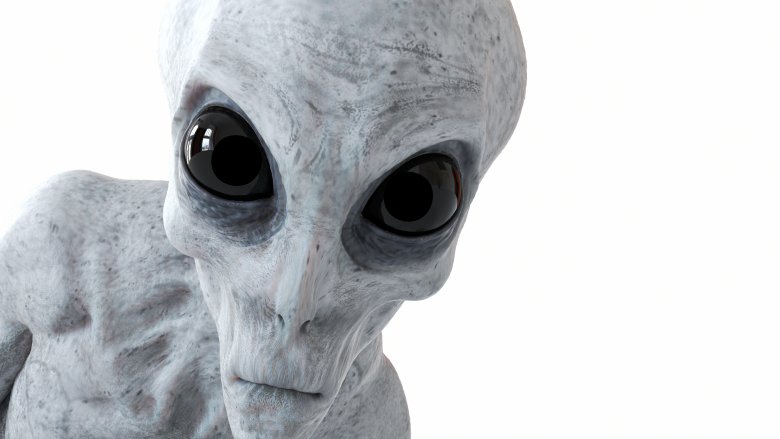
Shutterstock
The truth is, nobody actually knows why, exactly, this mysterious base is called Area 51. According to Dictionary.com, this name was first discovered on diagrams from the 1960s, and it's possible that the name is just a relic from the Atomic Energy Commission, which used a grid naming system (Area 13, Area 14, you can count) to title the various "safety experiment" locations within the land of Nellis Air Force Base. That said, Area 51 is far from the only name this location has had, and it's doubtful that those who work there call it that. If anything, they probably think of it as Groom Lake. The location's airport identifier code is KXTA, and according to Wired, another official name for it is Homey Airport. Because top-secret military installations are so homey, right? Maybe it's a reference to E.T.'s phone.
Anyhow, plenty of Area 51 nicknames have appeared throughout the years, as described by The New York Times, all of which sound straight out of a science fiction horror movie. These include Dreamland, the Box, the Ranch, or — simply enough — "the remote location." Shudder.
WHERE THERE'S WEIRD STUFF, TOURISM FOLLOWS
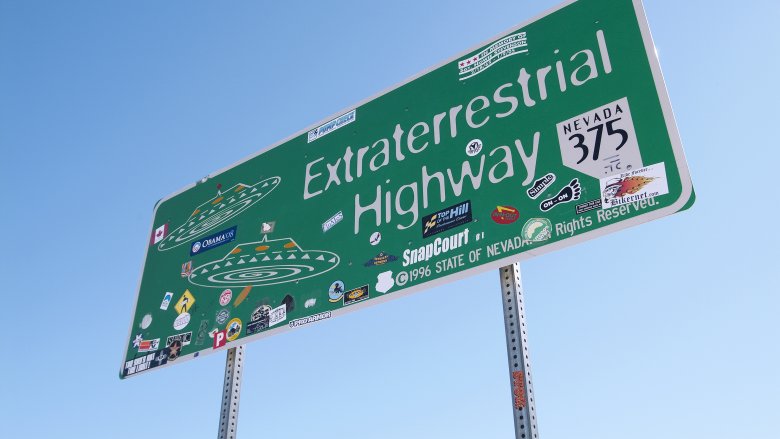
Shutterstock
Nobody goes into Area 51 unless they're invited, but the surrounding region has — predictably enough — flowered with exactly the sort of alien-themed tourism you'd hope to find in such a location. The New York Times writes that Nevada State Route 375 was named "the Extraterrestrial Highway" in 1996, and the area welcomes visitors from any planet to enjoy the various museums, restaurants, and hotels dedicated to the little green dudes, according to the Washington Post. Honestly, outside of Roswell, New Mexico, or the annual Exeter UFO Festival in New Hampshire, it's hard to find a more alien-friendly spot ... well, unless there really are alien bodies being dissected in Dreamland.
Tourists shouldn't expect to actually go inside Area 51, though. Also, don't believe all the hype: While salespeople love to claim that Nevada sees more annual UFO sightings than anywhere else in the country, USA Today reports that this honor actually belongs to Vermont, followed by Oregon.
Nevada, for what it's worth, ranks at #13.
BARACK OBAMA WAS THE FIRST PRESIDENT TO MENTION AREA 51
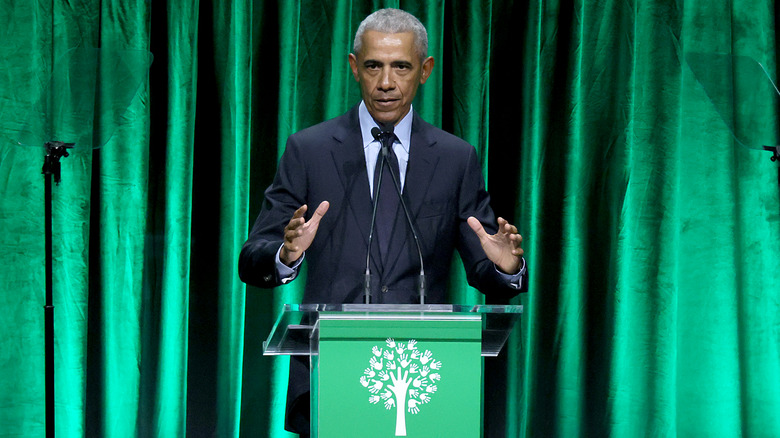
Dia Dipasupil/Getty Images
It's odd that the government is so reluctant to acknowledge the existence of a military base that's so well known to the masses. All the government's silence does is make us all the more curious about what's actually going on at Area 51. However, after decades of general secrecy about the base, in 2013 President Barack Obama became the first president to mention Area 51, but not to declassify anything juicy about it. No, the president brought it up in the form of a joke, according to NPR. Specifically, it was at the annual Kennedy Center Honors ceremony wherein actress Shirley MacLaine was being honored for her contributions to the arts. When presenting the actress, Obama said, "Now, when you first become president, one of the questions that people ask you is, 'What's really going on in Area 51?' When I wanted to know, I'd call Shirley MacLaine. I think I just became the first president to ever publicly mention Area 51. How's that, Shirley?"
While it's technically true that Obama was the first president to publicly mention Area 51, CBS News lists previous times when other presidents publicly mentioned Groom Lake, Nevada, which is generally thought to be an allusion to the infamous military base. For example, President Bill Clinton made references to Groom Lake in 1996, 1998, 1999, and 2000, while President George W. Bush referred to it 2001, 2002, 2003, and 2004.
EMPLOYEES REPORTEDLY FLY TO WORK ON JANET AIRLINES
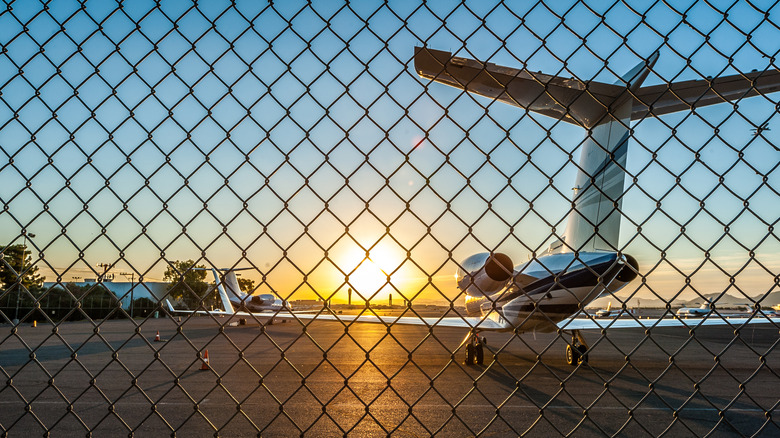
L3ankadi/Getty Images
Area 51 is so secretive that employees aren't even allowed to drive there for work but instead must take a designated plane to and from there. SOFREP states that the roughly 1,000 to 1,500 Area 51 employees fly to the base from Las Vegas' McCarran International Airport on JANET Airlines' jets. The airline has its own terminal at the airport and consists of a modest armada of Boeing 737-600 jets, as well as three Beechcraft 200Cs and two Beechcraft 1900s. Adding to the mystique of the aircraft is their appearance, which consist of all white paint jobs and no logos. While this may have been done to not attract attention to them, it's about as inconspicuous as a plain white van parked outside of your house for days on end.
According to SOFREP, some joke that JANET stands for "Just Another Non-Existent-Terminal." While that's probably not true, what is true is that the airline is owned by parent firm AECOM. And for those who are in the market for a new job -– ideally one with a secretive government operation –- Task & Purpose (via Military.com) has some details on pilot positions with the defense contractor. Applicants must have 3,000 hours as a pilot, as well a top-secret government clearance. It should go without saying that prospective pilots should be good at keeping secrets, of course. Still, for around $80,000 a year, the gig doesn't sound too bad.
PROJECT AQUATONE AND THE DEVELOPMENT OF OXCART AND NIGHTHAWK
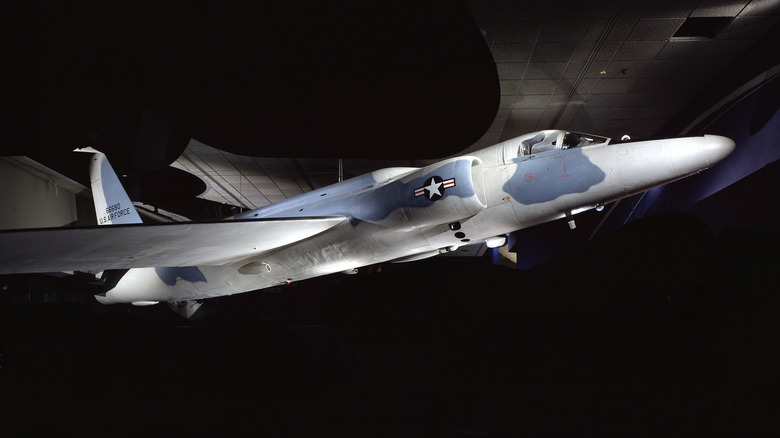
Heritage Images/Getty Images
The National Interest states that the United States grew concerned about reports of the Soviet Union's growing nuclear arsenal during the Cold War and needed a way to monitor their progress. Because of the Soviet Union's advanced air defense system, this would require the invention of a new kind of plane. That's when Lockheed came up with a spy plane that could fly higher than radar could detect. President Dwight D. Eisenhower signed off on the project, called Project Aquatone, and the U-2 spy plane was built. As Curtis Peebles writes in "Dark Eagles," a special facility was built near Groom Lake, Nevada, to test the plane, which would go on to be called Area 51.
Of course, the U-2 spy plane wasn't the only clandestine program worked on at Area 51. According to National Geographic, not long after Project Aquatone, the U.S. military began progress on Oxcart, another spy plane that could fly over Russian soil and collect important information without being detected. But because they knew when Soviet satellites would be flying over the base, personnel at Area 51 created a variety of solutions to make their job more difficult, such as building fake planes to confuse satellites and moving spy plane prototypes into sheds when satellites drew near. The F-117 Nighthawk is another plane tested at Area 51. As stated by Lockheed Martin, what made Nighthawk special was its ability to not only evade radar waves but to reflect them back, making it ideal for spy missions.
AREA 51 WAS INVOLVED IN A LAWSUIT
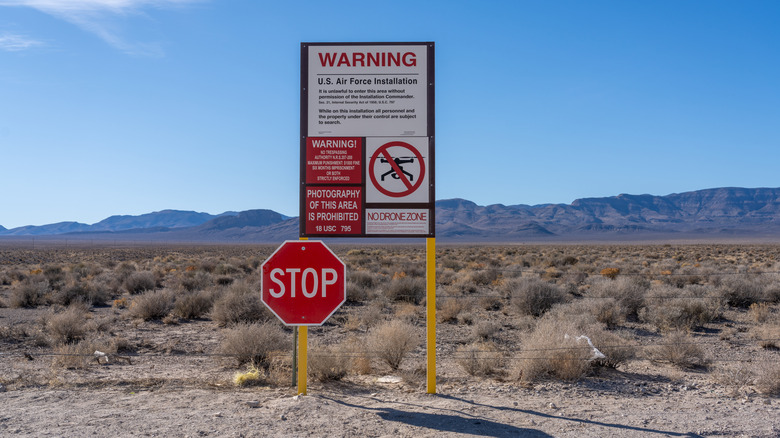
Brianpirwin/Getty Images
Filing a lawsuit against a military base whose existence the U.S. government has historically been reluctant to even acknowledge is no small feat, but that didn't stop Jonathan Turley who, as he states in the Los Angeles Times, did just that in the 1990s. According to Turley, several men who worked at Area 51 came to him regarding the health problems they suffered from their time at the base, stating that used equipment, waste, and other materials were being disposed of in a harmful and illegal manner. According to the suit, the matter in question was dumped into long trenches, covered in jet fuel, and set aflame, resulting in massive clouds of smoke around the base. The fumes, of course, are alleged to have caused numerous serious health problems in employees.
The Washington Post elaborates on the details of the lawsuit, which is not to seek monetary recompense but rather to force the military to divulge what chemicals the infirmed plaintiffs were exposed to so that they could get the medical treatment for their specific needs. Unfortunately, the U.S. government cited reasons related to national security for why it couldn't disclose the waste it was disposing of at the base. While the lawsuit did prompt the EPA to carry out an inspection of Area 51 -– the first in the secretive base's history –- its findings could not be shared.
HILARY CLINTON WANTED THE GOVERNMENT TO OPEN UP ABOUT AREA 51
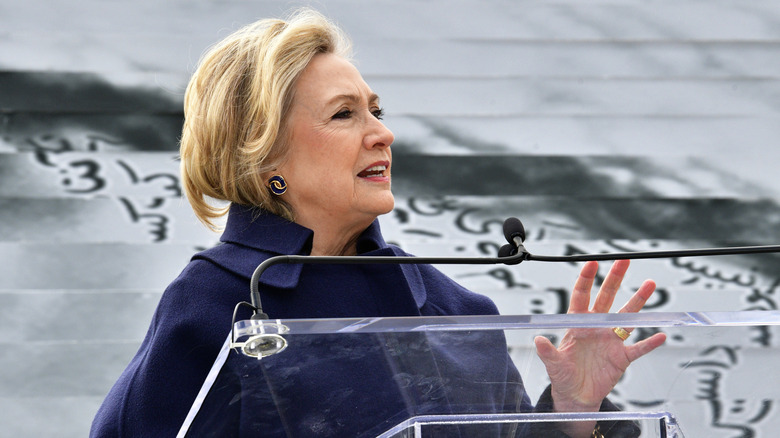
Eugene Gologursky/Getty Images
While it may seem like most in the U.S. government are remaining tight-lipped about Area 51, Hillary Clinton, the former secretary of state who ran for president in 2016, took a different approach. As stated in the Daily Caller, during an appearance on "Jimmy Kimmel Live," she told the host that, if elected president, "I would like us to go into those files and hopefully make as much of that public as possible. If there's nothing there, let's tell people there's nothing there." Clinton did qualify, however, that anything threatened national security would remain top secret from the public.
This seems a reasonable compromise, making it all the more confusing as to why so few others involved in government have made this proposition. The New York Times states that, during her presidential campaign, Clinton's statements about Area 51 resonated with conspiracy theory aficionados who've long speculated about what the secretive base is hiding. During a radio interview around this time, she even expressed her belief in the possibility of UFOs, saying, "I want to see what the information shows," but that "there's enough stories out there that I don't think everybody is just sitting in their kitchen making them up."
STORM AREA 51, EXPLAINED
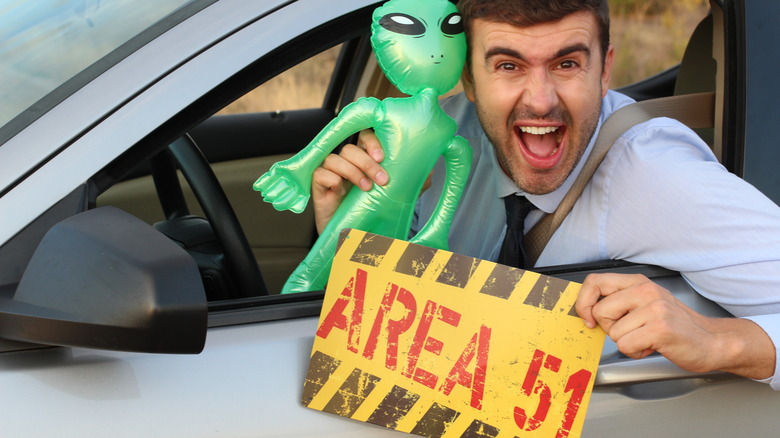
Ajr_images/Getty Images
CNN reported in 2019 that a Facebook event was created with the intent of gathering up as many people as possible to "storm" Area 51 to make contact with the aliens supposedly being kept there. Of course, the whole thing was a joke, as even a cursory look at the event's description shows that it's not to be taken seriously. For example, the event itself was called "Storm Area 51, They Can't Stop All of Us," with the description reassuring participants that doing a "Naruto run" at the base would allow them to dodge bullets. Even though the event page was obviously written as a gag, because more than 2 million people signed up for it, there was some speculation that some might take it seriously and make a charge at a heavily-guarded military base.
Luckily, however, not much came of the event, according to CNN. Apparently, only around 3,000 people showed up in the nearby region, but almost everyone decided that charging into Area 51 was a bad idea. Lincoln County Sheriff Kerry Lee told the outlet that "they did threaten that they were going to storm," but "once officers warned them about the consequences for storming the base, they did have second thoughts." The day wasn't entirely without incident, as someone was arrested for indecent exposure and another for threatening to storm Area 51. But overall, it was a fairly uneventful day, and police officers had largely positive interactions with the crowd that arrived.
RECOMMENDED
NEXT UP
FALSE AMERICAN HISTORY FACTS YOU ALWAYS THOUGHT WERE TRUE
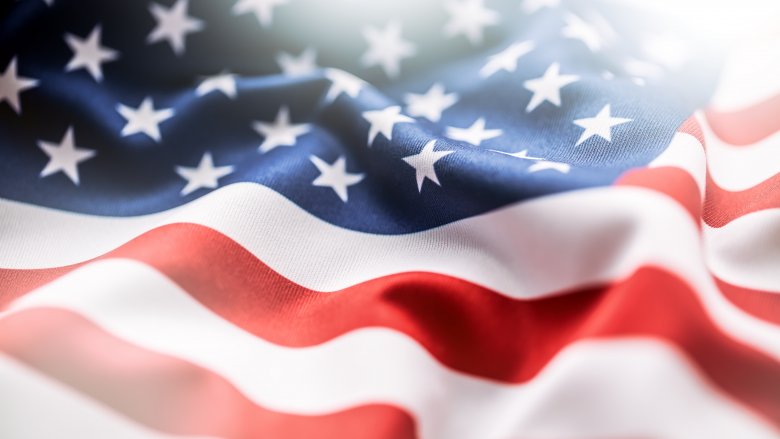
Shutterstock
BYDAVID G. TAYLOR/NOV. 18, 2016 7:16 AM EST
History tends to take on a life of its own over time. This leads to popular misconceptions forming in the public's mind about important people and events, particularly with early American history, and even with some events occurred during modern record-keeping. In the present day, every line a politician speaks publicly is meticulously documented and can be readily retrieved by eager fact-finders. (And nearly every line a politician speaks privately is quickly relayed by an anonymous source to a reporter, who writes up a quick summary and then starts reeling in those sweet, sweet social media clicks.)
But this was obviously not the case in the early years of the United States. It took a lot more effort to write things down and to preserve those writings. The result is authors sometimes incorrectly chronicling events in history books. With that in mind, below are a few "facts" about U.S. history that many people assume are true, but just plain aren't.
BETSY ROSS DESIGNED THE FIRST AMERICAN FLAG
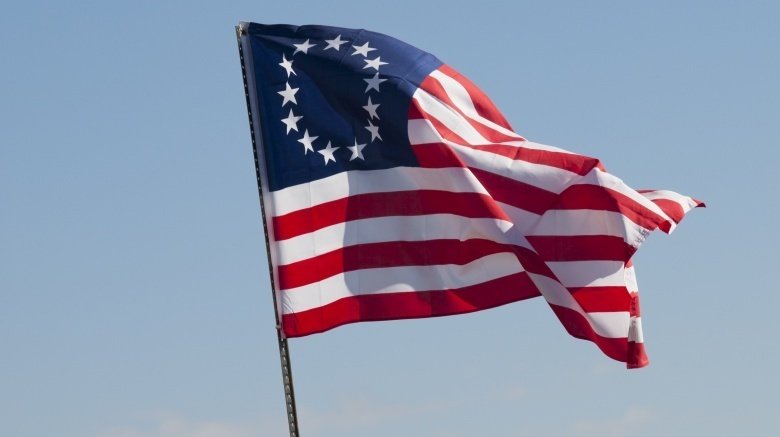
American children learn in elementary school that Betsy Ross created the first U.S. flag at the behest of George Washington. Ross also allegedly made some suggestions depicted in the final design, including five-pointed stars and their circular arrangement. While it's true that Ross was a Philadelphia-based flag-maker, the notion that she designed the first flag is likely false. Her grandson, William Canby, began spreading the story almost 100 years later, in 1870, and his only evidence were testimonials from family members. Most likely, the Betsy Ross story was simply a attention-grabbing family legend that somehow made it into American history books.
If it wasn't not Betsy Ross, then, then who is responsible for the first flag's appearance? The designer was possibly Francis Hopkinson, one of the signers of the Declaration of Independence.
THE CIVIL WAR ENDED AT APPOMATTOX
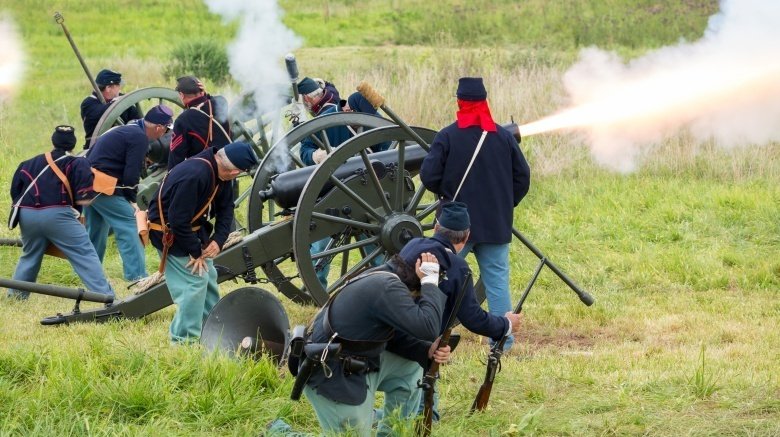
It's widely believed that the American Civil War ended when General Robert E. Lee surrendered to General Ulysses S. Grant, following the Battle of Appomattox Court House in Virginia on April 9, 1865. Lee's surrender, however, was hardly the end of the war. Several battles followed, most notably the Battle of Palmito Ranch near Brownsville, Texas that occurred more than a month later, on May 12-13, 1865. Despite news being slow in those days, both sides knew about Lee's surrender, and had even declared a ceasefire. Nevertheless, the two-day battle commenced when Union forces tried to capture Brownsville. Ultimately the Confederacy won this final land battle of the war, so they sure snagged that moral victory, at the absolute least.
AMERICAN TROOPS NEVER INVADED RUSSIA

Thankfully, the United States and the Soviet Union never engaged in direct military conflict during the Cold War (1947-1991). Nevertheless, many Americans think that means we never actually fought Russia, and thus do not know that President Woodrow Wilson sent thousands of U.S. troops to Russia decades earlier, in September 1918. These troops were part of a larger force that comprised soldiers from the first World War's Allied countries — including the United States, France, Great Britain, and Japan. Their mission was to support Russia's White Movement, an assemblage of anti-communist Russians opposed to the Bolsheviks — forerunners of the Soviet Union's Communist Party — that had seized power during the October Revolution.
The Allies' initial goal was to beat back the Bolsheviks, and thus enable Russia to re-enter World War I against Germany. World War I ended anyway in November 1918, and by 1919 the Red Army's victory over the Whites looked certain. As a result, the bulk of the Allied forces pulled out of Russia by 1920. Ultimately, about 174 American soldiers died over those two years. The intervention may seem like a footnote in U.S. history, but it served as a prelude to future Cold War-era tensions between the Soviet Union and the West.
THE EMANCIPATION PROCLAMATION FREED SLAVES IN THE UNITED STATES
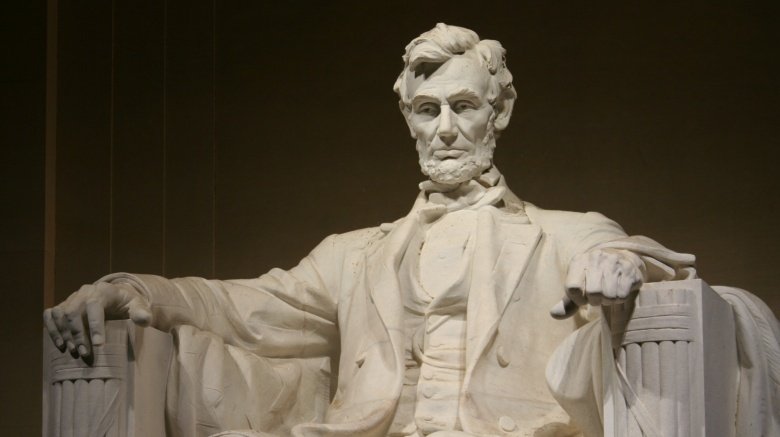
President Abraham Lincoln presented the Emancipation Proclamation on January 1, 1863. Despite what is popularly believed, the proclamation did not free all slaves in the United States and did not end slavery. In fact, the proclamation only freed slaves in the Confederate states. "You're free, come on up North!" The Confederacy, of course, was in open rebellion at that time and had little interest in obeying the laws of the enemy.
The proclamation did not apply to any of the slaveholding states that remained loyal to the Union — Delaware, Kentucky, Maryland, and Missouri. The proclamation was more a goodwill gesture, a promise that the Union would end slavery if it prevailed in the Civil War. The U.S. made good on this promise several years later, when it officially ended slavery following the ratification of the 13th Amendment to the Constitution ... unless you commit a crime. Then it's back to the old ways for you.
THE FLAG WE ALL THINK WAS THE NATIONAL FLAG OF THE CONFEDERACY, WASN'T
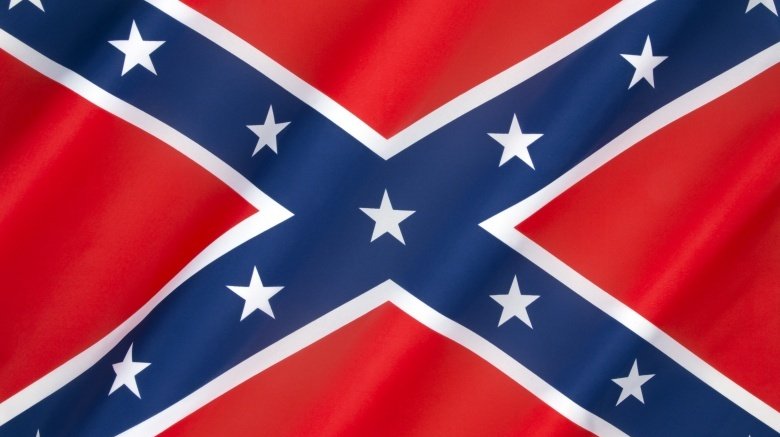
Another commonly held misconception is that the flag of the Confederate States of America was the recognizable — and super-controversial — blue cross and red background icon displayed above. This flag was never actually the official symbol of the Confederacy. It's actually one of the Confederate battle flags, very similar to the banner that the Army of Northern Virginia (led by General Robert E. Lee) flew during conflicts. The official flag of the Confederacy changed three times during the American Civil War (1861-1865), but was never the one that everybody assumes it is. The basic "blue cross, red background" design was eventually incorporated into the official flag, but it was always only a portion of it, minimized into the upper corner.
THE DECLARATION OF INDEPENDENCE IS WRITTEN ON HEMP PAPER
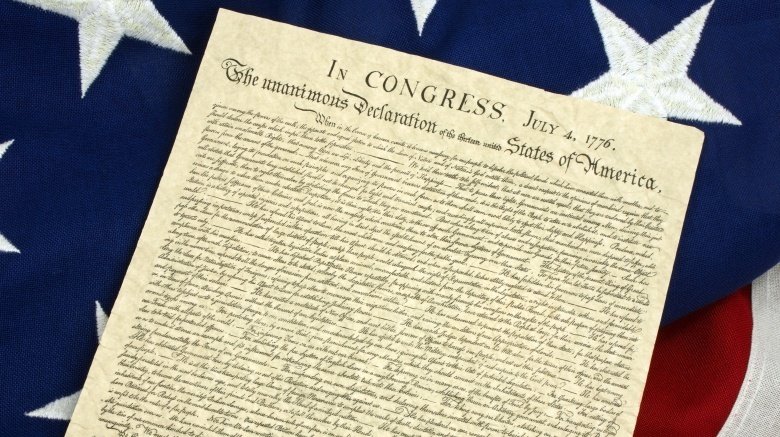
For the uninitiated, hemp is a type of cannabis related to marijuana. The chief difference between the two is that hemp contains very little of the chemical tetrahydrocannabinol (THC), the compound in marijuana that produces the euphoric "high" effect when you smoke it. Hemp fiber has historically been used for a wide number of applications, including creating paper, so at some point, a toker likely trying to relate to a Founding Father suggested that the Declaration of Independence is written on hemp paper. You can now find numerous Internet sites that repeat this claim, but we refuse to be one of them.
It's certainly an interesting hypothesis, but we can easily prove it false by, well, looking at the document itself. Sorry, Shaggy, but the Declaration of Independence is written on parchment, which is made out of animal hide. And no, the Constitution is not written on hemp either. It's possible that Thomas Jefferson wrote some drafts of the Declaration of Independence on hemp, but even if that were true, we're not sure what that revelation's supposed to prove, except that hemp paper was more popular then than it is today.
BEN FRANKLIN WANTED THE TURKEY TO BE THE U.S. NATIONAL BIRD
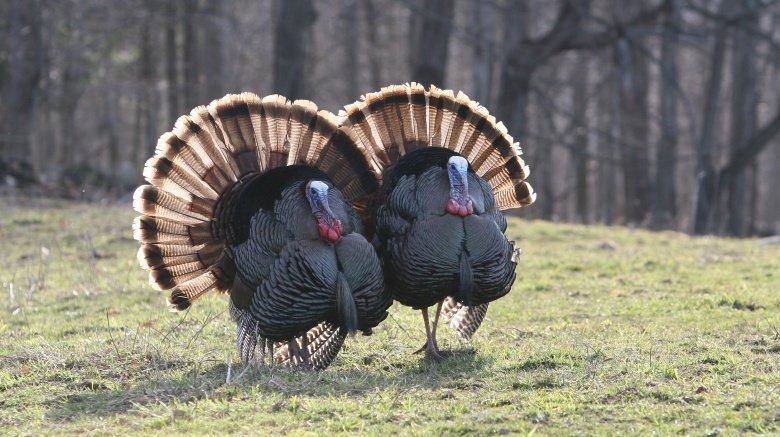
Another legend about one of our Founding Fathers is that Benjamin Franklin wanted the turkey, not the bald eagle, to be the United States' national bird. Franklin did question the choice of the bald eagle's placement on the Great Seal of the United States in a letter to his daughter, complaining that the eagle looked like a turkey on the seal. He then laments the choice of the bald eagle as the nation's bird, and praises the turkey's demeanor over the predatory raptor. Franklin wrote that the bald eagle is "a Bird of bad moral Character" who lazily steals food from other birds.
On the other hand, he writes the following about the turkey: "He is besides, though a little vain & silly, a Bird of Courage, and would not hesitate to attack a Grenadier of the British Guards who should presume to invade his Farm Yard with a red Coat on." It's obvious that Franklin is being facetious in this letter, employing the signature wit that made him famous. Regardless, he never explicitly states that the turkey should replace the bald eagle. Besides, as anyone suffering from a post-Thanksgiving food coma can attest, the turkey is certainly responsible for way more laziness than any eagle.
THE UNITED STATES WON ITS INDEPENDENCE BECAUSE OF ITS MILITARY TACTICS
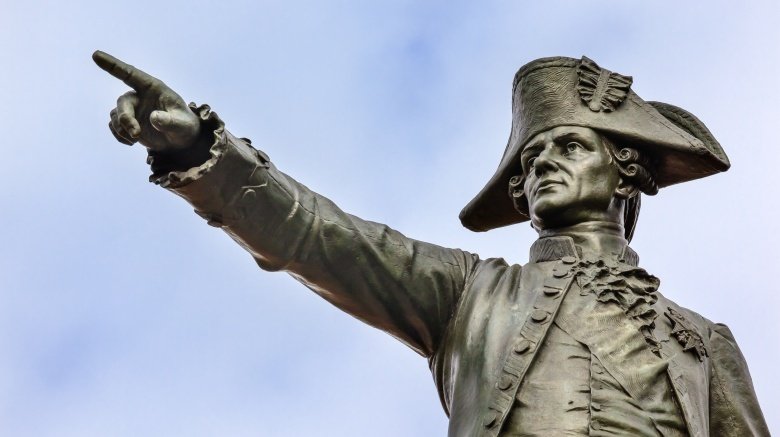
A popular refrain that you hear about the American Revolution is that the colonists defeated the British forces because they used hit-and-run, guerilla-style tactics that they learned from Native Americans. As the story goes, the more regimented British military troops could not adapt to effectively fight back. The reality is much more complicated. Prior to the American Revolution, colonists actually requested help from Britain, because their military training left them inept during clashes against hostile Native American tribes. So if they brits couldn't fight back, it's not because the Minutemen were too wild and crazy. It's simply because the brits taught them too well.
It's also untrue that General George Washington was a brilliant tactician. He made several blunders during the campaign, and even lamented his own skills as an effective general. The commander of French forces, Comte de Rochambeau (pictured above), actually formulated the campaign that eventually lead to the colonists' victory over the British at the Siege of Yorktown. The surrender of Lieutenant General Charles Cornwallis of England in 1781, at Yorktown, effectively ended the war. That being said, the real motivation for Great Britain giving up the fight wasn't that they were beaten beyond all hope, but rather the onerous financial cost of the war, combined with waning popular support.
THE LIBERTY BELL CRACKED ON JULY 4, 1776
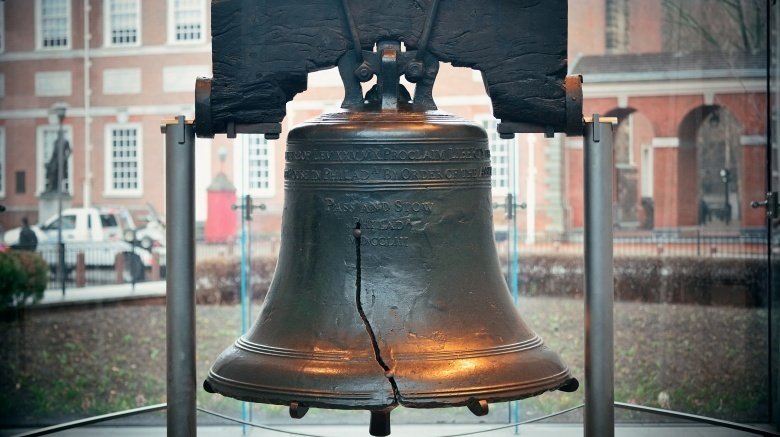
Several popular misconceptions exist about the Liberty Bell. First, no one called it the Liberty Bell during the American Revolution. The bell was initially known as the State House Bell and, appropriately enough, resided in the Pennsylvania State House. People didn't begin referring to it as the Liberty Bell until abolitionists labelled it as such during the 1800s.
Second, the notion that the bell cracked after being enthusiastically rung by patriots on July 4, 1776, is pure bunk. Actually it probably didn't ring at all on that famous day, mainly because the bell began to crack years earlier, starting in 1752, and required constant maintenance during its run in the Pennsylvania State House. The crack that you see today when visiting the bell in Philadelphia likely occurred in the 1840s. In short, the Liberty Bell was the equivalent of that car that you need to constantly throw money at to keep working. Nevertheless, it's still an important national symbol to this day.
REAGAN FREED THE IRAN HOSTAGES
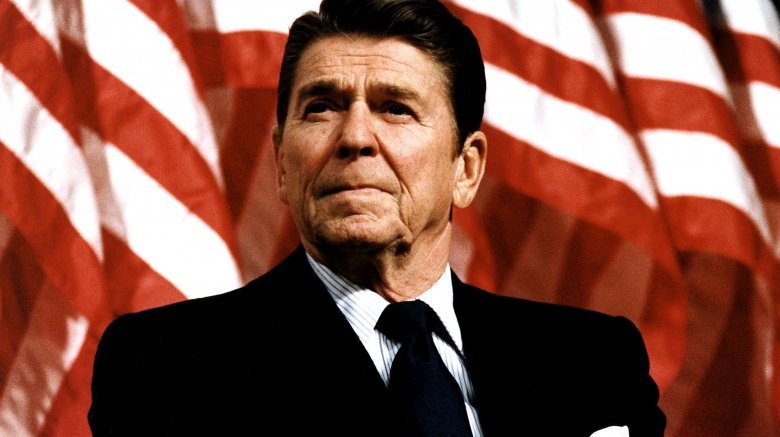
There's a persistent myth about President Ronald Reagan's foreign policy legacy that you've likely heard during recent political discussions. According to some, the Iran hostage crisis only ended because of Reagan's election. The story goes that Iran had no respect for Reagan's predecessor, President Jimmy Carter, but submitted and released the hostages in the face of a more powerful opponent like Reagan.
Thing is, this tale is a simplistic misunderstanding of what actually occurred. Reagan had nothing to do with the negotiations to release the hostages, but still received a lion's share of the credit for it. The Carter Administration had begun negotiating with Iran months earlier, in September 1980. But the Iranian government strongly disliked Jimmy Carter for providing aid to the Shah of Iran — the country's former monarch — and for a failed attempt to rescue the hostages months earlier. So while it's true that Iran did not release the hostages until President Reagan's inauguration day on January 20, 1981, its decision to do so had less to do with Reagan, and more with embarrassing President Carter.
SUPPORT FOR LEAVING THE UNION WAS UNIFORM ACROSS THE CONFEDERACY
Although 11 Southern states broke away from the U.S. to form the Confederate States of America, it would be a mistake to think everyone in these states supported secession. The reason that West Virginia even exists today is because its residents chose to break away from Virginia rather than follow it into the Confederacy.
Tennessee almost broke up too — almost 70 percent of voters in eastern Tennessee voted against seceding from the U.S. on June 8, 1861. After losing the vote, several counties in eastern Tennessee petitioned the state government in Nashville to allow the region to remain in the United States, but the Tennessee government rejected the request. In fact, Confederate troops had to occupy parts of both east Tennessee and northern Alabama to prevent rebellion.
There were several other pockets of Unionist support in the Confederacy, too. These were mostly areas where the majority-white population owned few slaves and saw no real reason to fight to keep them. Another notable example is Jones County, Mississippi, that formed the basis of the 2016 film Free State of Jones.
THE SIEGE OF YORKTOWN ENDED THE AMERICAN REVOLUTIONARY WAR
We learned in American history class that the nascent United States won the Revolutionary War after American and French forces — commanded by generals George Washington and Jean-Baptiste de Rochambeau — defeated the British at Yorktown on October 19, 1781. While this defeat effectively dashed the British's hope of quelling the colonial rebellion, it was hardly the final battle of the war. Instead, the last skirmish was the naval Battle of Cuddalore in the Bay of Bengal, off the coast of India, on June 20, 1783. That's right, the final battle of the American Revolution took place in coastal India, eighteen months after the whole thing was supposed to end.
How is that even possible? Well, recall that France sided with with the United States in 1778. Once it did so, France was also at war with Great Britain. The conflict between the British and the French was not restricted to the colonial U.S., and instead took place on a global scale. Ironically, the battle occurred as the United States (led by dignitaries Benjamin Franklin and Thomas Jefferson), Great Britain, and France were negotiating the formal end of hostilities in Paris. Ultimately the French prevailed in the Battle of Cuddalore. Vive la France!
WASHINGTON D.C. HAS ALWAYS BEEN THE CAPITAL OF THE U.S.
All Americans know Washington D.C. is the capital of America, but what they might not know is D.C. is actually our ninth capital city. The first capital was Philadelphia, where the Continental Congress convened in 1774 and signed the Declaration of Independence two years later. The the capital changed several times during the Revolutionary War — from Philadelphia to Baltimore to even Lancaster, Pennsylvania — as Congress constantly moved to keep one step ahead of the British Army.
In 1789, George Washington actually took the oath of office as the first president of the United States in New York City, meaning Federal Hall in the Big Apple briefly served as the first capital of the United States (under the U.S. Constitution) from 1789-1790. Philadelphia then became capital again, until the District of Columbia could be completed.
THE CIVIL WAR WAS FOUGHT OVER STATE'S RIGHTS
There is a lot of misinformation in the zeitgeist about the American Civil War. Most prominently, Americans seem confused about the cause of the war itself. A 2011 survey by the Pew Research Center found that 48 percent of Americans thought the war was caused by a battle over states' rights, and 38 percent thought it was because of slavery. It can't be both ... right?
Well, if you peruse the most direct source possible, the Confederate states' justifications for secession, it becomes abundantly clear that their primary reason for leaving the U.S. was indeed the preservation of slavery. "The new [Confederate] constitution has put at rest, forever, all the agitating questions relating to our peculiar institution African slavery as it exists amongst us the proper status of the negro in our form of civilization. This was the immediate cause of the late rupture and present revolution," said Alexander Stephens on March 21, 1861. Almost one year later he would become the first and only vice president of the Confederate States of America.
"Confederate states did claim the right to secede, but no state claimed to be seceding for that right. In fact, Confederates opposed states' rights — that is, the right of Northern states not to support slavery," wrote historian James W. Loewen in a Washington Post article on the issue. Then the Confederates attacked Fort Sumter and the war was on. Making things more confusing is the fact that Lincoln was strongly against slavery but initially argued that the war would be about keeping the Union together because he knew many in the North and on the border didn't care enough about slavery to go to war about it. Less than two years into the war, he signed the Emancipation Proclamation in an attempt to make it crystal clear for future armchair historians what was at stake.
ONLY JAPANESE-AMERICANS WERE INTERNED DURING WORLD WAR II
One of the darkest pages in U.S. history was Executive Order 9066, the decision by President Franklin Roosevelt to forcibly intern approximately 110,000 Japanese-Americans in camps during Worl War II. The U.S. government was fearful of espionage from the Japanese-American community after the attack on Pearl Harbor in December 1941. This fear caused the government to grossly violate the civil rights of thousands, by forcibly relocating them to ten internment camps primarily scattered throughout the western United States. The U.S. government didn't apologize until decades later, when President Reagan signed the Civil Liberties Act of 1988.
Yet, many don't realize that Japanese-Americans weren't the only group who were licked up in such camps. In addition to more than 11,000 German residents of the U.S., several thousand Japanese-Latin Americans were also sent to these camps. Peru, in particular, has a significant Japanese minority. Many Japanese-Peruvians descended from Japanese immigrants traveled to Peru in the 19th century, looking for work. By the time World War II rolled around, and the U.S. asked for Latin-American countries to arrest their Japanese populations, the Japanese-Peruvian population stood at about 25,000. This, combined with resentment toward the generally prosperous Japanese minority, was all the justification that some xenophobic elements of Peruvian society needed to deport their fellow countrymen to the U.S., and to those wretched camps
WORLD WAR II NEVER MADE IT TO THE U.S. MAINLAND
Americans, for the most part, assume that World War II never reached the United States mainland. Sure, we all know about Pearl Harbor, and some of us are even familiar with the Battle of the Aleutian Islands between the U.S. and the Japanese (June 1942 to August 1943). Yet neither Alaska or Hawaii are part of the mainland, nor were they even states at the time.
Yet, unbeknownst to some, the Japanese did attack the U.S. mainland several times during the war. In fact, it would seem that before hipsters, the greatest threat to our west coast was the Japanese military. For one, a Japanese submarine shelled the Ellwood Oil Field near Santa Barbara, California on February 23, 1942, and a few months later, on June 24, 1942, a different Japanese submarine opened fire on Fort Stevens in Oregon. In September 1942, on two occasions, the same submarine used a floatplane to drop incendiary bombs near Brookings, Oregon in hopes of starting a forest fire. Fortunately, none of these attacks caused major damage, but that doesn't mean they didn't happen.
THE PILGRIMS WERE ESCAPING RELIGIOUS PERSECUTION
As youths, many of us learn that the Pilgrims immigrated to the New World and founded a colony in Plymouth, Massachusetts in 1620, in order to escape the religious persecution they faced in England. This is all accurate, except for the bit about religious persecution. Religious intolerance was actually not a huge factor in the Pilgrims' decision to venture to North America. The Pilgrims, in fact, had already found the religious tolerance they sought in Holland.
So why leave that wonderland? What was the problem? They loaded up the Mayflower and crossed the Atlantic for two reasons: to maintain their English identity, and to pursue better economic opportunities. Also, the Pilgrims envisioned that someday, their likenesses would make adorable salt-and-pepper shakers — but that's just our theory.
THE SALEM WITCH TRIALS FEATURED BURNINGS GALORE
The Salem Witch Trials, which lasted from February 1692 to May 1693, is one of the most prominent examples of mass hysteria in American history. During this period, hundreds of people in Salem Village, Massachusetts were accused of witchcraft, and about twenty people were executed.
You popularly hear that the puritanical government burned these poor "witches" at the stake. This is, shockingly, yet another myth. Although witches were burned at the stake in medieval Europe, almost all the "witches" in Salem were hung. After all, firewood isn't cheap, folks, and Massachusetts gets cold! Just ask anyone who lives there. They'll tell you. Repeatedly, and loudly.
The only "witch" to escape hanging was Giles Corey, who had the distinct displeasure of being pressed to death with heavy rocks. Some people will do just about anything to get out of church.



0 Comments